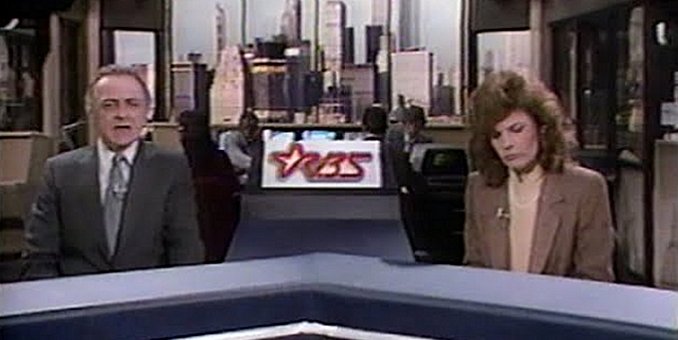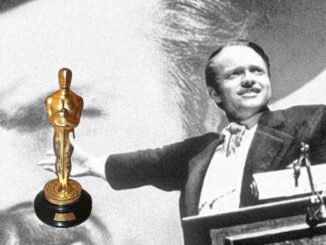
You know the film. It’s a film you have never heard of. The cast might be composed of actors you know and love or complete unknowns. A documentary that sounds interesting about a topic you might like. You stumble across it on streaming and wonder if it will be worth two hours of your time. This series will be devoted to reviewing films like these, the strange items that pop up when you are looking for a flick on the streaming service of your choice. This is “We Found It On Streaming”
 FILM: Special Bulletin
FILM: Special Bulletin
Release Date: March 20, 1983
Run Time: 105 Minutes.
Streaming Service(s): YouTube, Internet Archive
Rating: N/A (Made for TV)
A Charlotte, South Carolina TV crew stumbles upon the story of the century. While at the docks reporting on a labor issue, RBS reporter Steve Levitt (Christopher Allport) and his cameraman George Takashima (Robert Kay) stumble upon a skirmish between the Coast Guard and a group of terrorists fighting over a tugboat in the harbor. Several Coast Guard officers are seriously injured and several officers and the reporting team are taken hostage.
But these are no ordinary terrorists. These are anti-Nuclear Activists. They are looking to disarm the nukes in the area by obtaining the triggers for all the nuclear weapons in the area by 4:30 pm the next day. If they don’t get the triggers by then, they will detonate a nuclear bomb of their own creation to show the world the perils of nuclear proliferation. Their drama plays out over live television, as the reporters broadcast live from the tug as a condition of the terrorists releasing the Coast Guard members they had captured.
Special Bulletin, in case you are unfamiliar with it, is not a conventional movie. First airing on NBC on March 20, 1983, at the height of Nuclear Paranoia (It predates the more famous The Day After by seven months), the film is presented as a live news broadcast on the phony RBS network. The story unfolds in a series of live reports from not only the terrorist’s ship, but also from news conferences, field reporters and two hosts in the studio.
To avoid a similar type of paranoia that was caused by Orson Welles‘ infamous 1938 War of the Worlds radio broadcast, the film puts bumpers when the return from commercials telling everyone that what they are watching are not real.
This does not make the film any less harrowing. Perhaps it hits more with my generation, one that actually remembers doing “duck and cover” drills as a child in school. But, to me, the threat of the film is palpable. Being told through news reports adds an air of realism to the narrative. As the deadline grows closer, the tension increases, and peril becomes that much sharper.
The film was directed by Edward Zwick and written by Marshall Herskovitz, the pair that would go on to create thirtysomething a few years later. They do well in getting the story across in the live-news format, albeit greatly aided by the plot contrivance of having a reporter embedded with the terrorists. The exposition is presented well. It never seems awkward or forced. It never feels less than genuine.
The film is very prescient about what a world with a 24-hour news cycle would be like. CNN was not yet three years old at the time, but this film shows how sensational the news would become, how they would use their subjects for stories, and how people could use the media to control the message. This part of the film is just as timely today as the day it was made, if not timelier.
The acting is first rate, with a cast composed at the time unknowns. The most famous person in the cast at the time was Ed Flanders, who had started in St. Elsewherethe year before. However, cast features a pre-thirtysomething Miles Drentell David Clennon and pre-Sledge Hammer David Rasche as the terrorist leaders. Lane Smith appears as a Washington reporter, and Michael Madsen has a one scene cameo. Back when the movie was filmed, they were all unknown at the time, but even being recognizable today, they are still effective in their roles.
The film hasn’t been on video since it was part of Warner Archive’s print on demand program. This means the only version of the film you can find are bootleg versions of the film. The copy I watched was taken from a Chicago station complete with ads. It’s a credit to film that I stayed engrossed when the action was broken several times an hour with Gene Siskel advertising the Chicago Tribune and a young Deborah Norville with news breaks.
Special Bulletin works on many levels. It is a view into the past when “Movies of the Week” ruled television, when networks would be willing to take risks with content and format, and when fears of Nuclear War were prevalent. But besides all that, it is a great film that holds up today as well as it did the year it was released. Well worth tracking down.
Have you found a film on streaming that you’d like us to look at? Leave it in the comments and it might appear in a future installment of this feature.




